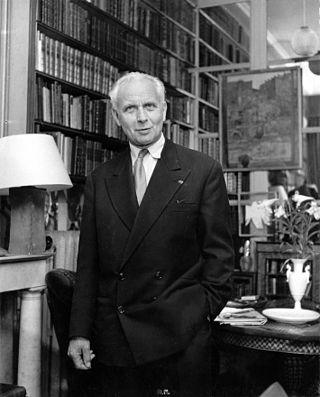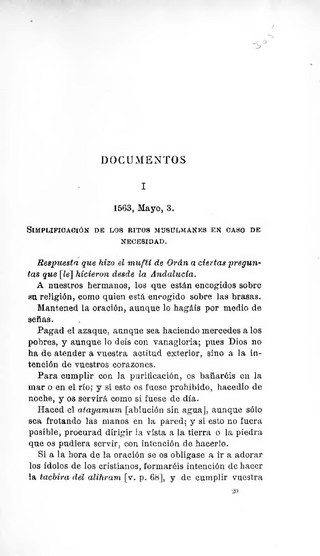This article relies largely or entirely on a single source .(August 2024) |
Le Fou d'Elsa is a 1963 novel written by Louis Aragon. [1]
This article relies largely or entirely on a single source .(August 2024) |
Le Fou d'Elsa is a 1963 novel written by Louis Aragon. [1]
In this book Aragon's intellectual work is reflected through the description of Arabic and Muslim culture in both poetry and prose. Aragon describes the relationships between the Muslim and Catholic world at the time of Inquisition in Spain by using the fall of Granada and the escape of Boabdil in front of Isabella the Catholic as a background.
As most of the books of Aragon, Le Fou d'Elsa is a book about love. Aragon announces a new woman to come, a woman called Elsa, in the quote "Woman is the future of man". But Le Fou d'Elsa is not only about love. The book is also a description of the beginnings of the depression of the Muslim world, first with the fall of Granada until the colonization.
Le Fou d'Elsa represents a political opinion as the book was written at the time of decolonization in France.
Nowadays, Le Fou d'Elsa is still a great book talking about tolerance and the treasures of all the different cultures.

Louis Aragon was a French poet who was one of the leading voices of the surrealist movement in France. He co-founded with André Breton and Philippe Soupault the surrealist review Littérature. He was also a novelist and editor, a long-time member of the Communist Party and a member of the Académie Goncourt. After 1959, he was a frequent nominee for the Nobel Prize in Literature.

Moriscos were former Muslims and their descendants whom the Catholic Church and Habsburg Spain commanded to forcibly convert to Christianity or face compulsory exile after Spain outlawed Islam. Spain had a sizeable Muslim population, the mudéjars, in the early 16th century.

Al-Andalus was the Muslim-ruled area of the Iberian Peninsula. The term is used by modern historians for the former Islamic states in modern-day Gibraltar, Portugal, Spain, and Southern France. The name describes the different Muslim states that controlled these territories at various times between 711 and 1492. At its greatest geographical extent, it occupied most of the peninsula and part of present-day southern France (Septimania) under Umayyad rule. These boundaries changed constantly through a series of conquests Western historiography has traditionally characterized as the Reconquista, eventually shrinking to the south and finally to the Emirate of Granada.

The Catholic Monarchs were Queen Isabella I of Castile and King Ferdinand II of Aragon, whose marriage and joint rule marked the de facto unification of Spain. They were both from the House of Trastámara and were second cousins, being both descended from John I of Castile; to remove the obstacle that this consanguinity would otherwise have posed to their marriage under canon law, they were given a papal dispensation by Sixtus IV. They married on October 19, 1469, in the city of Valladolid; Isabella was 18 years old and Ferdinand a year younger. It is generally accepted by most scholars that the unification of Spain can essentially be traced back to the marriage of Ferdinand and Isabella. Their reign was called by W.H. Prescott "the most glorious epoch in the annals of Spain".

The taifas were the independent Muslim principalities and kingdoms of the Iberian Peninsula, referred to by Muslims as al-Andalus, that emerged from the decline and fall of the Umayyad Caliphate of Córdoba between 1009 and 1031. They were a recurring feature of al-Andalus history.

Abu Abdallah Muhammad XII, known in Europe as Boabdil, was the 22nd and last Nasrid ruler of the Emirate of Granada in Iberia.

Pierrot le Fou is a 1965 French New Wave romantic crime drama road film written and directed by Jean-Luc Godard, starring Jean-Paul Belmondo and Anna Karina. The film is based on the 1962 novel Obsession by Lionel White. It was Godard's tenth feature film, released between Alphaville and Masculin, féminin. The plot follows Ferdinand, an unhappily married man, as he escapes his boring society and travels from Paris to the Mediterranean Sea with Marianne, a young woman chased by OAS hitmen from Algeria.

Spain in the Middle Ages is a period in the history of Spain that began in the 5th century following the fall of the Western Roman Empire and ended with the beginning of the early modern period in 1492.
Convivencia is an academic term, proposed by the Spanish philologist Américo Castro, regarding the period of Spanish history from the Muslim Umayyad conquest of Hispania in the early eighth century until the expulsion of the Jews in 1492. It claims that in the different Moorish Iberian kingdoms, the Muslims, Christians and Jews lived in relative peace. According to this interpretation of history, this period of religious diversity differs from later Spanish and Portuguese history when—as a result of expulsions and forced conversions—Catholicism became the sole religion in the Iberian Peninsula.

The Nasrid dynasty was an Arab dynasty that ruled the Emirate of Granada from 1232 to 1492. It was the last Muslim dynasty in the Iberian Peninsula. Twenty-three sultans ruled Granada from the founding of the dynasty in 1232 by Muhammad I until 2 January 1492, when Muhammad XII surrendered all lands to Isabella I of Castile. Today, the most visible evidence of the Nasrid dynasty is the Alhambra palace complex built under their reign.

The Albaicín, also spelled Albayzín, is a neighbourhood of Granada, Spain. It is centered around a hill on the north side of the Darro River which passes through the city. The neighbourhood is notable for its historic monuments and for largely retaining its medieval street plan dating back to the Nasrid period, although it nonetheless went through many physical and demographic changes after the end of the Reconquista in 1492. It was declared a World Heritage Site in 1994, as an extension of the historic site of the nearby Alhambra.

Ferdinand II was King of Aragon from 1479 until his death in 1516 As the husband and co-ruler of Queen Isabella I of Castile, he was also King of Castile from 1475 to 1504. He reigned jointly with Isabella over a dynastically unified Spain; together they are known as the Catholic Monarchs. Ferdinand is considered the de facto first king of Spain, and was described as such during his reign, even though, legally, Castile and Aragon remained two separate kingdoms until they were formally united by the Nueva Planta decrees issued between 1707 and 1716.

The Emirate of Granada, also known as the Nasrid Kingdom of Granada, was an Islamic polity in the southern Iberian Peninsula during the Late Middle Ages, ruled by the Nasrid dynasty. It was the last independent Muslim state in Western Europe.

The Granada War was a series of military campaigns between 1482 and 1492 during the reign of the Catholic Monarchs, Isabella I of Castile and Ferdinand II of Aragon, against the Nasrid dynasty's Emirate of Granada. It ended with the defeat of Granada and its annexation by Castile, ending the last remnant of Islamic rule on the Iberian peninsula.

Isabella I, also called Isabella the Catholic, was Queen of Castile and León from 1474 until her death in 1504. She was also Queen of Aragon from 1479 until her death as the wife of King Ferdinand II. Reigning together over a dynastically unified Spain, Isabella and Ferdinand are known as the Catholic Monarchs.

The First Rebellion of the Alpujarras were a series of uprisings by the Muslim population of the Kingdom of Granada, Crown of Castile against their Catholic rulers. They began in 1499 in the city of Granada in response to mass forced conversions of the Muslim population to the Catholic faith, which were perceived as violations of the 1491 Treaty of Granada. The uprising in the city quickly died down, but it was followed by more serious revolts in the nearby mountainous area of the Alpujarras. The Catholic forces, on some occasions led personally by King Ferdinand, succeeded in suppressing the revolts and inflicted severe punishment on the Muslim population.

The Oran fatwa was a responsum fatwa, or an Islamic legal opinion, issued in 1502 to address the crisis that occurred when Muslims in the Crown of Castile, in present-day Spain, were forced to convert to Christianity in 1500–1502. It was authored by mufti Ahmad ibn Abi Jum'ah, an Algerian scholar of Islamic law of the Maliki school; the term "Oran fatwa" was applied by modern scholars, due to the word "Al-Wahrani" that appears in the text as part of the author's name.

The forced conversions of Muslims in Spain were enacted through a series of edicts outlawing Islam in the lands of the Spanish Monarchy. This persecution was pursued by three Spanish kingdoms during the early 16th century: the Crown of Castile in 1500–1502, followed by Navarre in 1515–1516, and lastly the Crown of Aragon in 1523–1526.

Mudéjar were Muslims who remained in Iberia in the late medieval period following the Christian reconquest. It is also a term for Mudéjar art, which was much influenced by Islamic art, but produced typically by Christian craftsmen for Christian patrons.

Il n’y a pas d’amour heureux is a poem written by Louis Aragon in January 1943, and published in La Diane Française in 1944. The poem reflects on the inherent contradiction between love and the pain that it inevitably brings to those who experience it. An underlying meaning, made explicit in the final stanza, applies this theme to the French Resistance, in which Aragon participated.